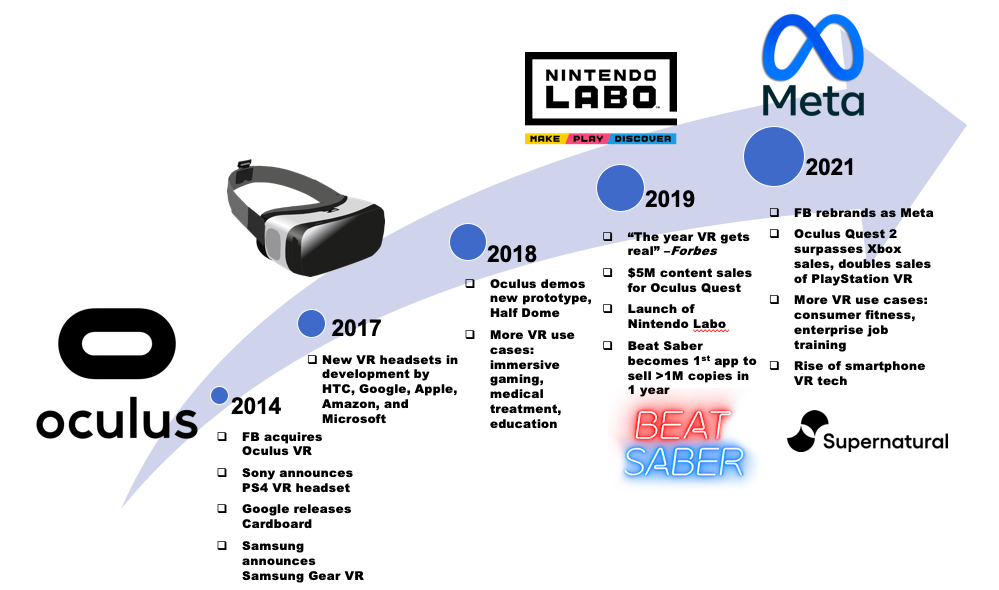When Zuck announced Facebook’s rebranding to Meta, it definitely woke up the world. Not only did it turbo charge sales of Oculus Quest 2, with over 10 million headsets sold in 2021, surpassing sales of Microsoft’s Xbox and doubling sales of Sony’s PlayStation VR, it also fueled more deals and interesting use cases, such as Decentraland selling virtual land within the metaverse.
Much of the virtual and augmented reality (VR/AR) technology here isn’t new. In fact, more than 50 years ago the US military was already leveraging VR/AR. However, both consumer and enterprise adoption of VR/AR is growing. I want to talk about the drivers and sustainability of that growth in this article, beginning with improvements in hardware.
Hardware costs drop while computer processing power increases
Remember Nintendo’s Virtual Boy? It was just one among several examples of when companies in the 1990s tried to turn VR headsets into commercial success. Almost all of them failed. Why? VR headsets were too expensive with components that were too difficult to source. And they were ahead of their time, because computers were too weak to render complex graphics and there were limited apps to play with. Simply put, these products weren’t worth the price.
When Facebook acquired Oculus VR in 2014 it was a defining moment for VR, and the technology has been gaining rapid momentum since then. More and more companies are developing VR, which is driving the reduction in price. In the meantime, computers and smartphones have become cheaper and much more powerful, enabling the creation of many killer apps.

More use cases emerge for both consumers and enterprises
Consumer fitness apps are perhaps one of the most successful use cases of VR (or of digital distribution channels in general) since the beginning of the global pandemic. Facebook made headlines with its acquisition of Within, the developer of fitness app Supernatural. With increased restraints on physical workouts, the virtual world is now a viable alternative. Apps like Supernatural provide consumers a (virtual) space for high quality, high impact cardio exercises while they shelter at home.
For decades, VR has been used for training in procedural centric occupations like the military and medicine. Whether piloting a supersonic jet or performing delicate surgery, we learn best by doing, so these types of work are natural fit for VR training.
In the enterprise space, corporate training is blooming with VR use cases as well. Fortune 500 companies are now using VR to train employees in a range of things, from soft skills to corporate culture. For example, Verizon developed VR training for their call-center employees to de-escalate calls from upset customers. Their insights are that the virtual world is immersive enough for employees to take the training seriously and it’s a safe place so people are less self-conscious and can speak more frankly. As a result, per employee training time decreased from 10 hours to 30 mins, and employees are more confident after the training.
People are ready for VR
Because I work at Vimeo, a leading video tech company, I have firsthand knowledge of how audiences today are craving video content, in both long and short form. Devices that can record or even live-stream are ubiquitous, allowing more opportunities for content creators. I believe VR brings the digital content consumption experience to the next level. Because it is a whole-body experience, people may never forget it. Or, in Tom Furness’s words, “When you put people into a place, you put the place into people.”
In fact, research from International Data Corp. (IDC) showed the AR/VR market is expected to exceed $70 billion in 2024. That being said, I don’t believe the VR market has crossed “the Chasm”. Perhaps it is in the Early Adopters stage, meaning less than 15% of consumers have adopted it thus far.
If so, there is definitely more VR growth to come, and possibly very soon. But will the metaverse replace human interaction? I don’t think so. The virtual world is an extension of our mind. With technology’s help, it gives us access to a virtual world that wouldn’t have been possible in the past, and one we can experience together now.
Conclusion
The metaverse may be in its early stage, but VR technology is something to watch, and it is here to stay. Several factors expediting the growth are reduced hardware prices, improved computing power, more killer apps, and a group of consumers are more ready for VR today than ever before.
As we look forward to the excitement the metaverse can bring to our lives, we should be aware there are downsides to everything. The amount of data that can be collected within the metaverse is massive. It also creates new data sources, from finger to facial movements, that companies can track. If you think Facebook is stalking you today by tracking your activities across devices, the magnitude of impact from data collected by the metaverse will have a multiplier effect.
On the other hand, the VR community is looking into ways to address these downsides. I am excited to stay tuned in to this community and be a part of its future development.